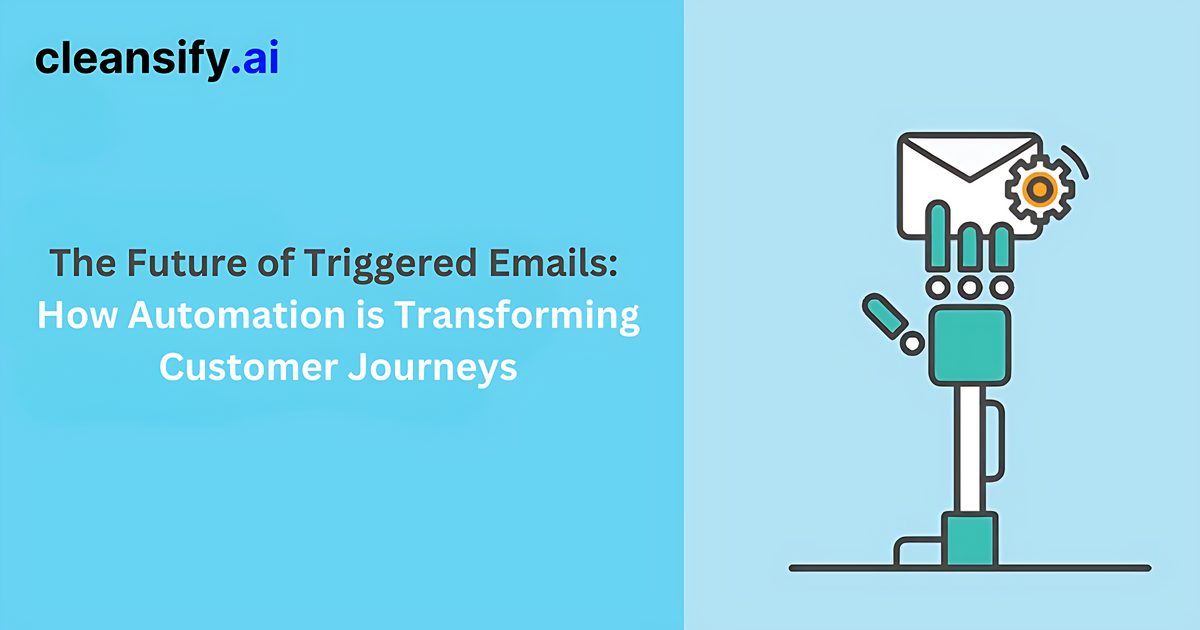The Future of Triggered Emails: How Automation is Transforming Customer Journeys

In today's digital age, businesses must use every tool at their disposal to reach customers and drive engagement. One such tool that has proven incredibly effective is triggered emails. These automated messages are sent in response to specific customer actions or behaviors and can be highly targeted and personalized. As automation technology continues to evolve, the possibilities for triggered emails are only growing. In this post, we'll explore the current state of triggered emails, how automation is changing them, and what the future holds for this powerful marketing tactic.
What Triggered Emails, And Why Do They Matter?
Triggered emails are automated email messages that are sent in response to a specific user action or behavior, such as signing up for a newsletter, making a purchase, or abandoning a shopping cart. These emails are designed to be highly relevant and timely, providing users with information or offers that are tailored to their specific interests and needs.
Triggered emails matter because they can be highly effective in driving engagement, conversions, and revenue. By sending messages that are highly relevant and timely, triggered emails can help to nurture customer relationships, improve brand loyalty, and increase customer lifetime value.
Here are some examples of triggered emails and their benefits:
- Welcome emails: These emails are sent to new subscribers or customers and can help to establish a positive first impression of your brand. They can also include information about your products or services, as well as incentives to encourage further engagement.
- Abandoned cart emails: When a customer adds items to their cart but doesn't complete the purchase, an abandoned cart email can be sent to remind them of what they left behind and encourage them to complete the transaction. These emails can be highly effective in reducing cart abandonment rates and increasing sales.
- Post-purchase follow-up emails: After a customer makes a purchase, a follow-up email can be sent to thank them for their business and encourage them to leave a review, refer a friend, or make a repeat purchase. These emails can help to build customer loyalty and increase the likelihood of repeat business.
How is Automation Transforming Customer Journeys?
Automation is transforming customer journeys in many ways. By automating certain processes and using technology to personalize and streamline interactions, businesses can provide a better customer experience, build stronger relationships with their customers, and ultimately drive growth. Here are a few specific examples of how automation is transforming customer journeys:
- Personalization: With automation, businesses can gather data on customers' behaviors and preferences and use that information to personalize their experiences. For example, they can use past purchase history to recommend new products or send targeted emails based on customers' interactions with their website.
- Timeliness: Automation allows businesses to send messages at the right moment in a customer's journey. For example, they can send triggered emails when a customer abandons a shopping cart or after a purchase to ask for feedback. By being timely and relevant, businesses can create more meaningful interactions with their customers.
- Consistency: Automation can help ensure that every customer interaction is consistent and on-brand. For example, businesses can use templates for automated emails, chatbots, and other communication channels to ensure that every message is consistent and professional.
- Efficiency: By automating specific processes, businesses can free up their teams to focus on more high-value tasks. For example, chatbots can handle routine customer service inquiries, while automated email campaigns can nurture leads and drive sales.
- Cross-channel integration: Automation technology can also help businesses create a seamless experience across multiple channels, such as social media, email, and messaging apps. By integrating these channels and using automation to track customer interactions, businesses can provide a more cohesive experience for their customers.
The Future of Triggered Emails
The future of triggered emails is likely to be shaped by several trends and developments in the email marketing industry, including:
- Personalization: As consumers become more accustomed to personalized content, triggered emails will need to be even more targeted and relevant to stand out. This may involve leveraging customer data and advanced segmentation techniques to tailor emails to individual preferences and behaviors.
- Automation: The use of artificial intelligence and machine learning algorithms to automate the creation and delivery of triggered emails is likely to increase, making it easier for businesses to scale their email marketing efforts while improving their targeting and effectiveness.
- Interactivity: Interactive elements such as videos, surveys, and quizzes will likely become more common in triggered emails, as they can increase engagement and provide a more immersive experience for users.
- Accessibility: With more consumers using mobile devices to access their email, triggered emails will need to be optimized for mobile devices to ensure they are accessible and easy to read on smaller screens.
- Privacy and security: With growing concerns around data privacy and security, businesses will need to ensure that they are collecting and using customer data transparent and ethically while also implementing robust security measures to protect against data breaches.
Conclusion
In conclusion, it's clear that triggered emails are here to stay, and automation is only making them more effective. By leveraging the latest technology, businesses can send highly personalized, timely messages that engage customers and drive conversions. As we look to the future, it's exciting to think about the possibilities for triggered emails, from AI-powered content recommendations to sophisticated cross-channel campaigns. No matter what the future holds, one thing is certain: triggered emails will continue to be a powerful tool for businesses looking to connect with their customers and drive growth.